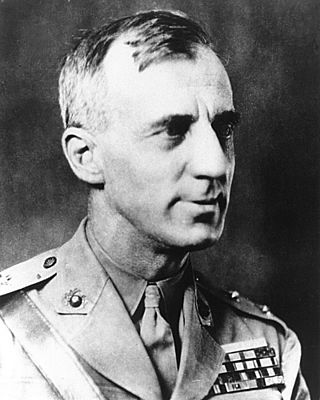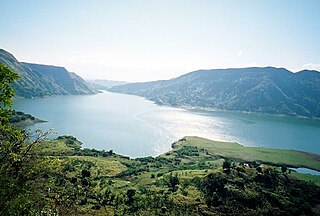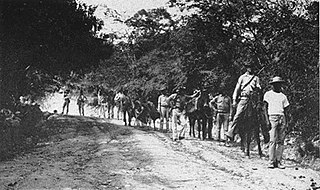
Lewis Burwell "Chesty" Puller was a United States Marine Corps officer. Beginning his career fighting guerillas in Haiti and Nicaragua as part of the Banana Wars, he later served with distinction in World War II and the Korean War as a senior officer. By the time of his retirement in 1955, he had reached the rank of lieutenant general.

Major General Smedley Darlington Butler, nicknamed the Maverick Marine, was a senior United States Marine Corps officer. During his 34-year career, he fought in the Philippine–American War, the Boxer Rebellion, the Mexican Revolution, World War I, and the Banana Wars. At the time of his death, Butler was the most decorated Marine in U.S. history. By the end of his career, Butler had received sixteen medals, including five for heroism; he is the only Marine to be awarded the Brevet Medal as well as two Medals of Honor, all for separate actions.

Centre (French) or Sant is a central department of Haiti, located in the center of the country along the border with the Dominican Republic. As of 2015, its estimated population was 746,236. Its capital is Hinche.

The United States occupation of Haiti began on July 28, 1915, when 330 U.S. Marines landed at Port-au-Prince, Haiti, after the National City Bank of New York convinced the President of the United States, Woodrow Wilson, to take control of Haiti's political and financial interests. The July 1915 invasion took place following years of socioeconomic instability within Haiti that culminated with the lynching of President of Haiti Vilbrun Guillaume Sam by a mob angered by his decision to order the executions of political prisoners. The invasion and subsequent occupation was promoted by growing American business interests in Haiti, especially the National City Bank of New York, which had withheld funds from Haiti and paid rebels to destabilize the nation through the Bank of the Republic of Haiti with an aim at inducing American intervention.

Daniel Joseph Daly was a United States Marine and one of nineteen U.S. servicemen to have been awarded the Medal of Honor twice. Daly and Major General Smedley Butler are the only Marines who earned two Medals of Honor for two separate acts of valor.
Fort Rivière is a ruined mountain fort in Haiti on the summit of Montagne Noire, Saint-Raphaël Arrondissement. It is on the north coast of Haiti to the south of Grande-Rivière-du-Nord and 20 miles south of Cap-Haïtien. It was a French bastion fort that was the site of the defeat of the Haitian rebel force called the Cacos on 17 November 1915.

The United States occupation of Nicaragua from 1912 to 1933 was part of the Banana Wars, when the U.S. military invaded various Latin American countries from 1898 to 1934. The formal occupation began in 1912, even though there were various other assaults by the U.S. in Nicaragua throughout this period. American military interventions in Nicaragua were designed to stop any other nation except the United States of America from building a Nicaraguan Canal.

Charlemagne Masséna Péralte was a Haitian nationalist leader who opposed the United States occupation of Haiti in 1915. Leading guerrilla fighters called the Cacos, he posed such a challenge to the US forces in Haiti that the occupying forces had to upgrade their presence in the country; he was eventually killed by American troops. Where he was symbolically crucified, Péralte remains a highly praised hero in Haiti.

The first United States occupation of the Dominican Republic lasted from 1916 to 1924. It aimed to force the Dominicans to repay their large debts to European creditors, whose governments threatened military intervention. On May 13, 1916, Rear Admiral William B. Caperton forced the Dominican Republic's Secretary of War Desiderio Arias, who had seized power from President Juan Isidro Jimenes Pereyra, to leave Santo Domingo by threatening the city with naval bombardment. The Marines landed three days later and established effective control of the country within two months. Three major roads were built, largely for military purposes, connecting for the first time the capital with Santiago in the Cibao, Azua in the west, and San Pedro de Macorís in the east; and the system of forced labor used by the Americans in Haiti was absent in the Dominican Republic.

The Banana Wars were a series of conflicts that consisted of military occupation, police action, and intervention by the United States in Central America and the Caribbean between the end of the Spanish–American War in 1898 and the inception of the Good Neighbor Policy in 1934. The military interventions were primarily carried out by the United States Marine Corps, which also developed a manual, the Small Wars Manual (1921) based on their experiences. On occasion, the United States Navy provided gunfire support and the United States Army also deployed troops.

Major General William Peterkin Upshur was the recipient of the United States' highest military decoration—the Medal of Honor—for his actions in 1915 during the Haitian Campaign.

Herman Henry Hanneken was a United States Marine Corps officer and a recipient of the U.S. military's highest decoration, the Medal of Honor.

The Battle of Fort Dipitie was fought in October 1915 during the United States occupation of Haiti. U.S. Marines and rebel Haitians — known as "Cacos" — fought at the Grande Riviere which resulted in the destruction of Fort Dipitie, an outpost of Fort Capois.
The Battle of Fort Rivière was the most remembered battle of the United States occupation of Haiti in 1915. U.S Marines and sailors fought at Fort Rivière against rebel Cacos.
The Nicaraguan Civil War of 1926–1927, or the Constitutionalist War, broke out after a coup d'état by Emiliano Chamorro, a member of the Conservative Party, removed Nicaragua's democratically elected government, resulting in a rebellion by members of the Liberal Party. The conflict came to an end after a military and diplomatic intervention by the United States resulted in the Pact of Espino Negro, which began the Peace of Tipitapa. Although the civil war came to an end, one Liberal general, Augusto César Sandino, refused to lay down his arms and waged the Sandino Rebellion against the Nicaraguan government and the US Marine Corps until 1933.

The Gendarmerie of Haiti, also known as the Haitian Constabulary, was a gendarmerie raised by the United States during its occupation of Haiti in the early 20th century. Established in late 1915, the gendarmerie was operational from 1916 until 1928, during which time it was Haiti's only military force, earning a reputation for active interference in civilian government that may have set the stage for the future politicization of Haiti's armed forces.
The Battle of Port-au-Prince, or "la débâcle", took place on January 15, 1920 when Haitian rebels, known as Cacos, attacked the capital of Haiti during the Second Caco War and the American occupation of Haiti.
The Battle of Sapotillal, or the Battle of Zapotillal or Zapotillo Ridge, took place on the 9 October 1927 during the American occupation of Nicaragua of 1926–1933 and the Sandino Rebellion. The battle was an unsuccessful attempt by American and Nicaraguan government forces to rescue two downed American airmen.
In Haitian history, Cacos were bodies of armed men, originally drawn from the country's enslaved population, who came to wield power in the mountainous regions of Haiti following the victory of the Haitian Revolution in 1804. The nickname "cacos" was derived from local terms for the red-plumed Hispaniolan trogon because the insurgents "used to hide, like the bird of the same name, under the leaves so as to come unexpectedly upon and attack their enemy."
The Les Cayes massacre, also known as the Marchaterre massacre, was a massacre on 6 December 1929 in Les Cayes perpetrated by United States Marine Corps (USMC) troops against Haitians protesting the United States occupation of Haiti. The massacre was instrumental in placing pressure on the United States to withdraw its occupying forces from Haiti.












